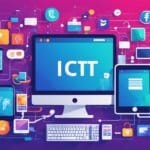Table of Contents
The digital divide is a significant issue in society, creating disparities in digital access and digital literacy. It refers to the gap between demographics and regions that have access to modern information and communications technology and those that don’t. This divide encompasses both the technical and financial ability to utilize available technology and the access to the internet. Sadly, the consequences of this digital divide are far-reaching and impactful.
One of the consequences of the digital divide is the isolation experienced by those without digital access. In today’s interconnected world, not having access to the internet can leave individuals feeling disconnected from society and cut off from important information and opportunities. Additionally, the digital divide poses significant educational barriers, particularly as more and more learning moves online. Students without access to digital resources and tools are at a disadvantage, hindering their educational success.
Another consequence of the digital divide is gender discrimination. Women, especially those in marginalized communities, face limited access to education and information due to a lack of digital access. This perpetuates existing gender disparities and hinders progress towards gender equality.
Economically, the digital divide has a profound impact. Without digital access and literacy skills, individuals and communities miss out on job opportunities and the ability to develop wealth. This further perpetuates socioeconomic inequalities and prevents economic growth.
It is crucial to address the digital divide to ensure social inclusion and equity. Efforts aimed at bridging this divide include programs focused on internet affordability, improving digital literacy, and investing in infrastructure development. Governments, organizations, and institutions must collaborate to provide comprehensive solutions that address the various aspects of the digital divide.
Addressing the digital divide is not only a matter of access and technology—it is a matter of creating a fair and equal society where everyone has the opportunity to thrive in the digital age.
What Is the Digital Divide?
The digital divide is a multifaceted issue that encompasses the technical and financial ability to utilize available technology, as well as access (or lack thereof) to the internet. It has evolved over time, initially describing the gap between those with cellphone access and those without. Today, it refers to the disparities in access to technology and the internet that exist across various demographics and regions.
The digital divide manifests itself in different forms, including:
- Developed and developing countries: There is a significant gap in digital access between countries with advanced technological infrastructure and those still striving for economic and technological development.
- Urban and rural populations: Access to technology and the internet is often more readily available in urban areas compared to rural areas, primarily due to differences in infrastructure and connectivity.
- Youth and educated individuals versus older and less educated individuals: Younger generations and those with higher levels of education tend to have better access to and proficiency in digital technologies.
- Gender disparities: Women, particularly in certain regions and cultures, face barriers to digital access and literacy, further exacerbating the digital divide.
The coronavirus pandemic has exacerbated the digital divide, shedding light on the disparities in digital coverage. The shift to remote learning has highlighted the challenges faced by students without reliable internet access or the necessary devices for online education. Furthermore, the digital divide has affected vaccine distribution, with digital registration and appointment systems creating barriers for those without internet access.
“The digital divide encompasses the technical and financial ability to utilize available technology, along with access (or a lack of access) to the internet.”
The digital divide is an evolving issue that requires attention and action to bridge the gap and ensure equal access to technology and the internet for all individuals and communities.
The Global Digital Divide
The global digital divide is a complex issue that goes beyond economic development. Despite rising incomes in many developing countries, there remains a significant lack of internet infrastructure. This hinders access to digital resources and connectivity, widening the gap between those who have reliable internet access and those who do not.
Internet penetration rates vary widely across continents and regions, influenced by factors such as geographical location and government policies. Some areas benefit from better access due to favorable infrastructure development and supportive regulations, while others struggle with inadequate connectivity.
The urban-rural divide plays a crucial role in shaping internet access. Urban areas generally have higher levels of connectivity compared to rural areas, where limited infrastructure can impede access to the internet. This disparity in connectivity further deepens the global digital divide.
“Initiatives to bridge the global digital divide must address not just economic development, but also the variations in connectivity and the urban-rural divide.” – Digital Inclusion Advocate
There are concerns that the digital divide is not narrowing fast enough and may even be widening in certain regions. This has the potential to exacerbate existing inequalities, stifling economic growth, education opportunities, and social inclusion.

| Continent | Internet Penetration Rate |
|---|---|
| Americas | 85% |
| Europe | 87% |
| Asia | 53% |
| Africa | 39% |
| Oceania | 73% |
Consequences of the Digital Divide
The digital divide has significant consequences, impacting various aspects of society and individuals’ lives. Let’s explore some of the key consequences resulting from this divide.
1. Isolation
One of the primary consequences of the digital divide is isolation. Individuals without internet access or digital literacy skills often find themselves disconnected from society. With the increasing reliance on digital platforms for communication, information, and social interaction, those on the wrong side of the divide can feel left out and excluded.
2. Educational Barriers
The digital divide creates significant educational barriers, particularly as more learning moves online. Students without access to the internet or the necessary devices face limitations in accessing educational resources, online classes, and digital learning tools. This disparity in educational opportunities can hinder their academic progress and future prospects.
3. Gender Discrimination
The digital divide exacerbates gender discrimination by limiting women’s access to education, information, and opportunities. In many societies, women face additional barriers to digital inclusion, such as cultural norms, limited resources, and societal biases. This perpetuates gender inequalities, hindering women’s empowerment and participation in the digital world.
4. Economic Impact
The digital divide has a profound economic impact. Lack of digital access and skills hinders job opportunities and upward mobility, widening existing economic disparities. Additionally, businesses and entrepreneurs without access to online platforms may face challenges in reaching customers, expanding their markets, and driving economic growth in their communities.
Bridging the Digital Divide
Addressing the digital divide requires a multi-faceted approach, involving various programs and initiatives aimed at reducing disparities in digital access and skills. These efforts focus on enhancing internet affordability, promoting digital literacy, and investing in infrastructure to ensure equitable connectivity for all. Bridging the digital divide is a crucial step towards achieving digital inclusion and empowering individuals and communities in the digital age.
One notable organization working towards internet affordability is the Alliance for Affordable Internet (A4AI). A4AI advocates for policy and regulatory reforms that enable affordable and accessible broadband services. By reducing broadband costs, A4AI aims to make internet access more affordable for those who have been disproportionately affected by high prices, thus contributing to bridging the digital divide.
Another innovative initiative is Starlink, a project by SpaceX that utilizes satellite technology to provide high-speed internet access in remote and underserved areas. By leveraging a constellation of satellites in low Earth orbit, Starlink seeks to offer reliable internet connectivity to regions where traditional infrastructure is limited. This revolutionary approach has the potential to bridge the digital divide by extending internet access to areas that were previously underserved.
Furthermore, governments around the world have implemented digital literacy programs to enhance individuals’ skills and knowledge in using digital technologies effectively. These programs focus on improving digital literacy among marginalized communities, seniors, and other underserved populations. By equipping individuals with the necessary digital literacy skills, these initiatives empower them to fully participate in the digital ecosystem and bridge the digital divide.
Recognizing the critical importance of infrastructure investment in narrowing the digital divide, the Infrastructure Investment and Jobs Act includes funding to expand broadband access and improve connectivity. This comprehensive legislation aims to address the gaps in internet access and ensure that every individual, regardless of their geographical location or socioeconomic background, has the opportunity to thrive in the digital era.
Benefits of Bridging the Digital Divide
“Bridging the digital divide can unlock tremendous potential for social and economic prosperity. It empowers individuals with access to vital information, educational resources, and employment opportunities.”
By bridging the digital divide, society can enjoy numerous benefits. Increased internet affordability and availability enable access to vital information, educational resources, and employment opportunities, leveling the playing field for all individuals. Digital literacy programs empower individuals to navigate the digital landscape confidently, fostering digital inclusion and reducing disparities in digital skills. Additionally, infrastructure investment creates the necessary backbone for connectivity, thereby expanding access to underserved communities and promoting socioeconomic development.
| Program/Initiative | Key Focus |
|---|---|
| Alliance for Affordable Internet (A4AI) | Reducing broadband costs |
| Starlink | Providing high-speed internet via satellites |
| Digital literacy programs | Improving skills and knowledge |
| Infrastructure Investment and Jobs Act | Expanding broadband access and connectivity |
Efforts to bridge the digital divide must be a collaborative endeavor involving governments, organizations, and institutions. By investing in comprehensive initiatives that address affordability, literacy, and infrastructure, we can create a more equitable society and ensure that no one is left behind in the digital age.
The Digital Divide in Education
The digital divide in education is a significant challenge that exists between students who have access to adequate technology and those who do not. This divide disproportionately affects students from marginalized communities, low-income individuals, and populations experiencing homelessness. The lack of access to high-speed internet and devices creates barriers to educational success, hindering the completion of homework and participation in remote learning.
The disparities resulting from the digital divide deepen socioeconomic inequalities and have a profound impact on academic outcomes. Students without access to the necessary technology face difficulties in acquiring the digital skills and knowledge required for modern education. As a result, they are at a disadvantage compared to their peers who can seamlessly navigate the digital landscape.
The COVID-19 pandemic has further exacerbated the digital divide in education, as schools shifted to remote learning. Many students without the necessary resources faced immense challenges in accessing online classes, educational materials, and reliable internet connections. This highlighted the urgent need for equity in online learning and bridging the gap in access to resources.
To address the digital divide in education, efforts must focus on enhancing access to technology, promoting technology integration in the learning environment, and ensuring equal opportunities for all students. This includes providing affordable internet access, distributing devices to students in need, and implementing comprehensive technology training initiatives for educators and students. By narrowing the digital divide in education, we can foster equal educational opportunities and empower students for success in the digital age.
FAQ
What is the digital divide?
The digital divide refers to the gap between demographics and regions that have access to modern information and communications technology and those that don’t. It encompasses the technical and financial ability to utilize available technology and access to the internet.
How does the digital divide affect society?
The digital divide has significant consequences, including isolation, educational barriers, and gender discrimination. It hinders job opportunities and wealth development, contributing to socioeconomic disparities. Closing the digital divide is essential for social inclusion and economic growth.
How does the digital divide impact education?
The digital divide in education refers to the gap between those with sufficient access to technology and those without. It hinders educational success, completion of homework, and participation in remote learning. Students from marginalized communities and low-income individuals are most affected.
What efforts are being made to bridge the digital divide?
Various programs and initiatives aim to bridge the digital divide. The Alliance for Affordable Internet (A4AI) focuses on reducing broadband costs, Starlink provides high-speed internet via satellites, and many countries run digital literacy programs to improve skills. The bipartisan Infrastructure Investment and Jobs Act includes funding to narrow the digital divide.













